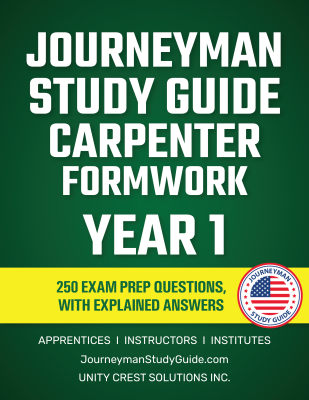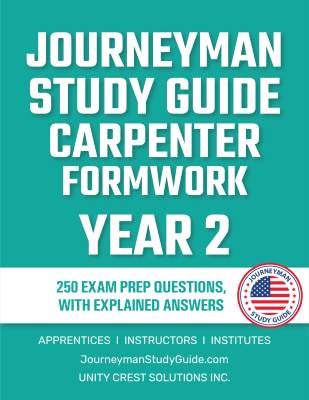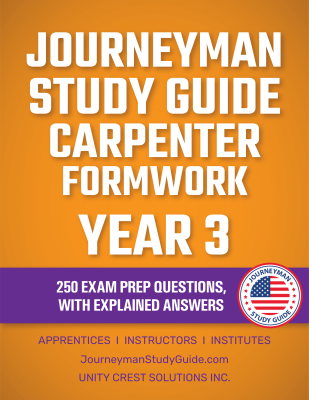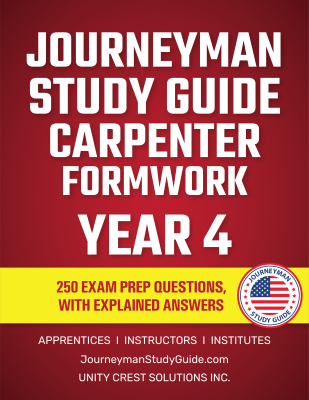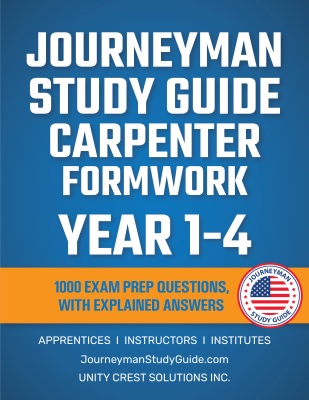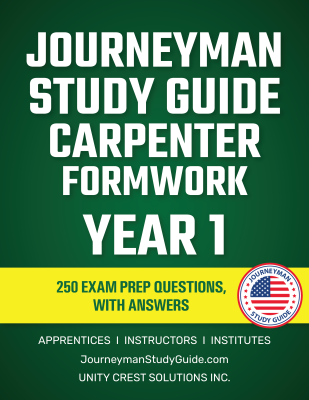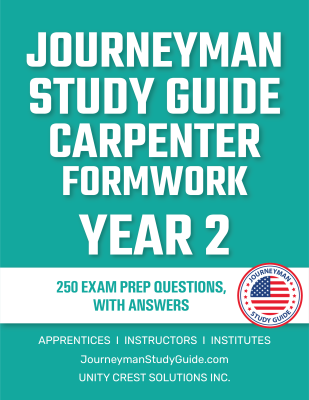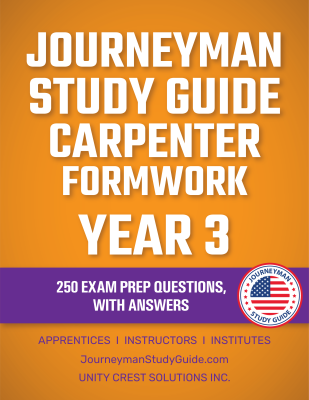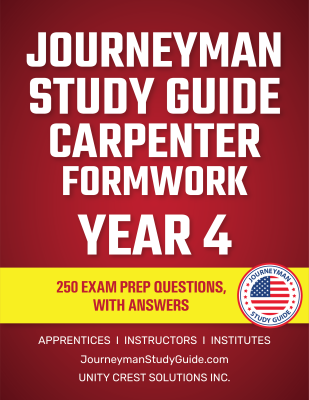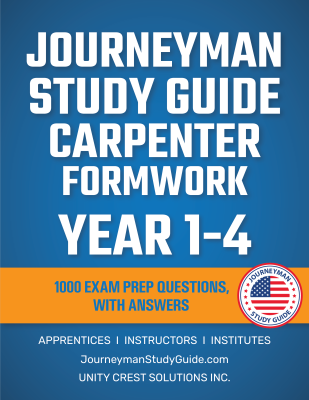Questions, Answers, & Explanations
Get clear explanations behind every answer, perfect for deeper learning and more thorough exam preparation.
Site Updates in Progress: Things might look different as we work on enhancing your experience.
What is a Formwork Carpenter?
Formwork carpenters are specialized tradespeople responsible for constructing temporary molds or frameworks used to shape poured concrete for buildings, bridges, tunnels, and other infrastructure projects. Their expertise ensures that concrete structures are formed with precision, strength, and durability. In large-scale commercial and industrial projects, formwork carpenters play a critical role in shaping the foundation of America’s built environment.
Key Responsibilities
Formwork carpenters use technical skills and construction knowledge to create temporary structures that support fresh concrete until it hardens. Their tasks include:
Skills and Traits for Success
Successful formwork carpenters possess a blend of technical ability, problem-solving skills, and physical endurance:
Industries Where Formwork Carpenters Thrive
Formwork carpenters are in high demand across multiple sectors:
Why Choose This Career?
Formwork carpentry is a respected trade offering job stability, strong wages, and long-term career growth:
Get Certified and Advance Your Career
Formwork carpenters can boost their skills and job prospects with professional certification. Our study guides, Q&A products, and interactive online tests are designed specifically for aspiring formwork carpenters. Build your expertise, master key concepts, and prepare for certification with our expertly crafted resources.
What to Expect on the Carpenter – Formwork Certification Exam
The Carpenter – Formwork Certification Exam is designed to assess a tradesperson’s knowledge of structural concrete formwork, blueprint reading, material calculations, and OSHA safety standards. Many American construction firms, The United Brotherhood of Carpenters (UBC), and major infrastructure contractors require certification as proof of expertise in large-scale formwork projects.
Exam Format
The exam consists of multiple-choice and practical application questions covering essential knowledge areas:
Key Topics Covered
The exam evaluates essential skills across multiple areas:
Passing Requirements
A minimum score of 70% or higher is typically required to pass the written portion. Some certifications may also include a practical skills test, where candidates demonstrate formwork construction techniques.
Prepare with Confidence
Our Q&A and Q/A Explanation study materials break down complex topics into easy-to-understand content. Our interactive Online Tests simulate real exam conditions, providing a running score and instant feedback.
What Types of Questions Are on the Exam?
The Carpenter – Formwork Certification Exam evaluates knowledge of construction techniques, safety protocols, and formwork assembly methods. Familiarity with common question formats will help you succeed.
Common Question Formats
Sample Questions
Study Smarter, Pass Faster
Our Q&A products help you pinpoint weaknesses, while our Q/A Explanation resources provide deeper understanding. Online Tests give real-time feedback to prepare you for success.
What Is a Typical Workday Like?
Formwork carpenters start early, typically at 6:30 or 7:00 AM, preparing tools, reviewing blueprints, and coordinating with concrete workers. The majority of the day is spent measuring, cutting, and assembling formwork systems to exact specifications. Carpenters may work on large-scale commercial buildings, bridges, or infrastructure projects. By the afternoon, inspections ensure the formwork is secure before concrete pouring begins. The day concludes with job site cleanup and material storage.
Long-Term Career Opportunities
Formwork carpenters can progress through multiple career stages, from apprentice to experienced professional. Many specialize in high-rise construction, highway bridgework, or large-scale industrial formwork projects.
Career Progression Steps
Union and Certification Benefits
Why Invest in Your Career?
Advancing in formwork carpentry leads to higher pay, specialized expertise, and long-term job security. Whether you aim to become a master carpenter or start your own contracting business, professional certification is key to success.
How Much Can You Earn as a Formwork Carpenter?
Wages for formwork carpenters vary depending on experience, location, union affiliation, and industry demand. The construction sector continues to see steady job growth, especially in large metropolitan areas where major infrastructure projects are ongoing.
Wage Breakdown by Experience Level
Factors That Impact Earnings
Career Growth & Financial Stability
Formwork carpentry is a high-demand trade that provides long-term job security and steady wage increases. Many certified formwork carpenters find employment with top-tier general contractors, infrastructure firms, and specialized formwork companies.
Maximize Your Earning Potential
Advance your career with our study guides, Q&A resources, and interactive online tests designed to help you pass certification exams and improve your skills.
Essential Tools for Formwork Carpenters
Formwork carpentry requires a combination of hand tools, power tools, and safety equipment to complete projects efficiently. Investing in high-quality tools ensures precision, durability, and workplace safety.
Must-Have Tools for the Job
Top U.S. Suppliers for Construction Tools
Recommended Training & Certification Programs
Why the Right Tools & Resources Matter
Investing in reliable tools, quality education, and professional certifications can significantly impact career success and earning potential. Formwork carpenters who use the right tools and continuously upgrade their skills stay competitive in the workforce and secure better job opportunities.
Get Equipped for Success
Prepare for your certification and improve your expertise with our comprehensive study guides, Q&A resources, and interactive practice tests.
Where Can You Train to Become a Formwork Carpenter?
Education and apprenticeship programs are critical for developing the skills needed to become a certified formwork carpenter. Training combines classroom instruction and hands-on experience, preparing students for careers in commercial and industrial construction.
Types of Training Programs
Key Skills Taught in Training Programs
Choosing the Right Program
Advance Your Skills with Professional Training
Becoming a certified formwork carpenter requires dedication, hands-on experience, and ongoing learning. Our Q&A study materials and interactive tests help you reinforce key concepts and prepare for exams.
Why Join a Union or Work with a Reputable Employer?
Union membership and working with top-tier employers provide job security, competitive wages, and career advancement opportunities. The United Brotherhood of Carpenters (UBC) offers training, job placement, and benefits, making it a strong choice for formwork carpenters.
Benefits of Union Membership
Major Employers & Contractors
Find the Best Career Opportunities
Enhance your employability by getting certified and joining a union. Use our study guides, Q&A materials, and online tests to ensure success.
How to Stay Ahead in the Formwork Carpentry Industry
The construction industry is constantly evolving with advancements in materials, safety regulations, and construction technology. Formwork carpenters who stay informed about these trends and develop specialized skills are more likely to secure high-paying, long-term positions with top construction firms.
Emerging Trends in Formwork Carpentry
Best Practices for Career Growth
Challenges & Opportunities in the Industry
Staying Competitive in the Job Market
Continuous learning and skill-building are key to career advancement. Our Q&A materials, Q/A Explanation guides, and interactive online tests help formwork carpenters stay ahead of industry trends and prepare for certification exams.
Get clear explanations behind every answer, perfect for deeper learning and more thorough exam preparation.
Quick and easy practice to test your knowledge anytime, anywhere—ideal for simple, on-the-go preparation.

